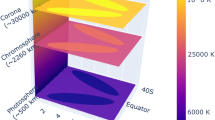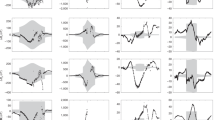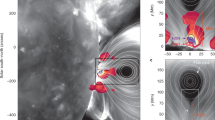Abstract
THE interplanetary magnetic field within several astronomical units of the Sun appears to have one polarity in most of the hemisphere north of the solar equatorial plane and the opposite polarity in most of the hemisphere south of the equatorial plane1–7. The two hemispheres are separated by a curved current sheet that typically crosses the solar equatorial plane in either two or four places, thus dividing the equatorial region into either two or four sectors. Near sunspot minimum, at 1 AU the curved current sheet has a spread in latitude of typically ± 15°, so that the sector boundary (the current sheet separating the two hemispheres of opposed field polarity) is almost parallel to the solar equatorial plane. In the photosphere, on the other hand, the sector boundary makes an angle of ∼ 90° with the equatorial plane8. At 1.5 R⊙, in 1972 and 1973, the angle between the sector boundary and the equatorial plane was ∼ 45° (ref. 9), and at 3–10 R⊙ the angle between boundary and plane was ∼ 25° (ref. 10). A schematic diagram of this structure for the case of four sectors is shown in Fig. 1. We here propose that a connection exists between the extent of these magnetic fields and the observed variations in cosmic ray intensity at the Earth.
This is a preview of subscription content, access via your institution
Access options
Subscribe to this journal
Receive 51 print issues and online access
$199.00 per year
only $3.90 per issue
Buy this article
- Purchase on Springer Link
- Instant access to full article PDF
Prices may be subject to local taxes which are calculated during checkout
Similar content being viewed by others
References
Schatten, K., Solar Wind (edit. by Sonnett, C. P., Coleman, P. J., and Wilcox, J. M.), 65–92 (Scientific and Technical Office, NASA, 1972).
Schultz, M., Astrophys. Space Sci., 24, 371–383 (1973).
Sawyer, C., Geophys. Res. Lett., 1, 295–297 (1974).
Alfven, H., Proc. Nobel Symposium on the Physics of Hot Plasma in the Magnetosphere (Kiruna, Sweden, 1975).
Levy, E. H., Proc. 14th int. Cosmic Ray Conf., 15–29 August 1975, 4, 1215–1220 (Max-Planck-Institut für Extraterrestrische Physik, München, FRG, 1975).
Svalgaard, L., Wilcox, J. M., Scherrer, P. H., and Howard, R., Sol. Phys., 45, 83–91 (1975).
Saito, T., Sci. Rep. Tohoku Univ., Geophys., 23, 37–54 (1975).
Wilcox, J. M., Space Sci. Rev., 8, 258–328 (1968).
Hansen, S., Sawyer, C., and Hansen, R. T., Geophys. Res. Lett., 1, 13–15 (1974).
Howard, R. A., and Koomen, M. J., Sol. Phys., 37, 469–475 (1974).
Vsekhsvjatsky, S. K., The Solar Corona, Proc. int. astr. Un. Symp., 16, Cloudcroft, New Mexico, 28–30 August 1961 (edit. by Evans, J. W.) 271–280 (Academic, New York, 1963).
Diodato, L., Moreno, G., Signorini, C., and Ogilvie, K. W., J. geophys. Res., 79, 5095–5108 (1974).
Barouch, E., and King, J. H., 14th int. Cosmic Ray Conf., 15–29 August 1975, 3, 1036–1041 (Max-Planck-Institut für Extraterrestrische Physik, München, FRG, 1975).
Rosenberg, R. L., and Coleman, P. J., Jr., J. geophys. Res., 74, 5611–5622 (1969).
Wilcox, J. M., and Scherrer, P. H., J. geophys. Res., 77, 5385–5388 (1972).
Svalgaard, L., J. geophys. Res., 77, 4027–4034 (1972).
Russell, C. T., and Rosenberg, R. L., Sol. Phys., 37, 251–256 (1974).
Wilcox, J. M., Svalgaard, L., and Hedgecock, P. C., J. geophys. Res., 80, 3685–3688 (1975).
Vernov, S. O., Charakhchyan, A. N., Stozhkov, Ju. I., and Charakhchyan, T. N., Proc. 14th int. Cosmic Ray Conf., 15–29 August 1975, 3, 1015–1024 (Max-Planck-Institut für Extraterrestrische Physik, München, FRG, 1975).
Author information
Authors and Affiliations
Rights and permissions
About this article
Cite this article
SVALGAARD, L., WILCOX, J. Structure of the extended solar magnetic field and the sunspot cycle variation in cosmic ray intensity. Nature 262, 766–768 (1976). https://doi.org/10.1038/262766a0
Received:
Accepted:
Published:
Issue Date:
DOI: https://doi.org/10.1038/262766a0
This article is cited by
-
Migrating Dynamo Waves and Consequences for Stellar Current Sheets
Solar Physics (2022)
-
Dynamo-based scheme for forecasting the magnitude of solar activity cycles
Solar Physics (1991)
-
North-south asymmetry in the heliospheric current sheet and the IMF sector structure
Solar Physics (1988)
-
A spatially confined long-lived stream of solar particles
Solar Physics (1986)
-
Latitudinal and solar-cycle dependence of the interplanetary magnetic field predominant polarity
Solar Physics (1982)
Comments
By submitting a comment you agree to abide by our Terms and Community Guidelines. If you find something abusive or that does not comply with our terms or guidelines please flag it as inappropriate.



